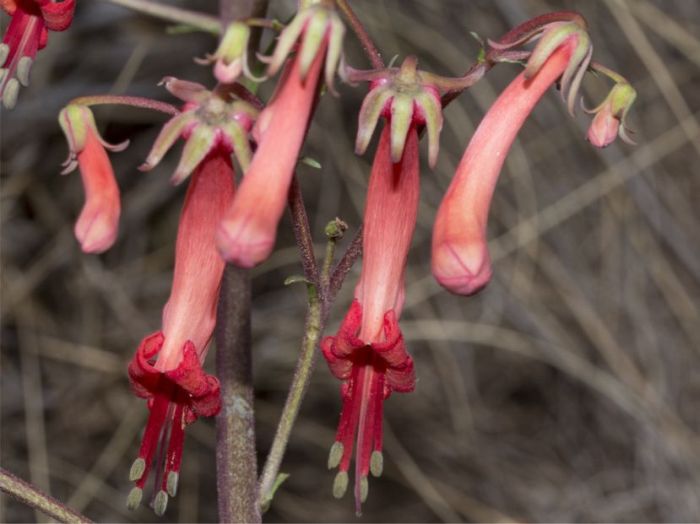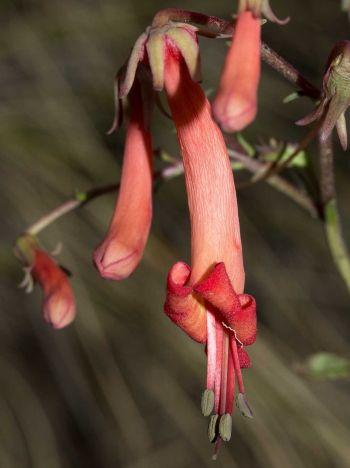Phygelius capensis
Phygelius capensis E.Mey. ex Benth.
Family: Scrophulariaceae
Common names: southern river bell, wild fuchsia, Cape fuchsia (Eng.); rivierklokkie, foksia (Afr.); metsi-matsho (Sesotho)
Introduction
Phygelius capensis is a hardy, evergreen semi-shrub that bears wonderful bright red or orange, drooping, tubular flowers throughout summer.

Description
Description
Phygelius capensis is a fairly small, evergreen herbaceous shrub, 0.3–1.5 m tall, with dark green ovate leaves and tall spikes of nodding, tubular, red or orange flowers in summer, from October to July.

Conservation Status
Status
According to the Red List of South African plants, Phygelius capensis is not threatened; it is assessed as Least Concern (LC).

Distribution and habitat
Distribution description
Phygelius capensis is usually found at high altitudes in the mountains of Swaziland, Lesotho and South Africa, where it occurs in the Eastern Cape, Free State, KwaZulu-Natal, Mpumalanga and Western Cape Provinces. It is fairly common in the Drakensberg.

Derivation of name and historical aspects
History
The name Phygelius is derived from the Greek words, phugo, meaning ‘to shun’, and helios, ‘the sun’, referring to its shady habitat. The species name capensis, means ‘of’ or ‘from the Cape’.
Phygelius is an endemic genus of southern Africa and there are only 2 species, Phygelius capensis and P. aequalis, which are much alike but can be distinguished as follows: the tubular flowers are a little shorter and broader in P. capensis, and the flower stalk is bent so that the flowers are angled towards the main stem. Also, the mouth of the flower tube is oblique in P. capensis, but it is round in P. aequalis. Their habitat is also different, Phygelius aequalis is known to grow widely in the valleys of the Little Berg, at altitudes of about 1 500 m, whereas P. capensis is generally found growing at much higher altitudes, of about 3 000 m, in the Giant’s Castle area.

Ecology
Ecology
Its bright red or orange flowers attract various pollinators into the garden, such as butterflies, bees, and nectar-feeding birds, especially sunbirds, and insect-eating birds.

Uses
Use
The plant is used in traditional medicine, and is also used as a charm against lightning. It is a fast-growing, hardy shrub and makes an ideal ornamental for a garden flower bed, and an outdoor pot plant, in sun or semi-shade. It thrives in damp areas and in normal garden conditions. It attracts wildlife into the garden.

Growing Phygelius capensis
Grow
For plant enthusiasts, Phygelius capensis is an easy plant to grow from seed or cuttings. Sow seeds in early spring or summer, make holes for seeds, once sown, cover lightly with soil, and water regularly. It will take approximately 2 weeks for seeds to germinate, at about 20–25ºC temperature.
Take cuttings from young fresh mother stock plants, use a tray filled with a mix of rich composted soil. For rapid rooting, use a rooting hormone powder and bottom heating, and water regularly.
It is quite easy to take care of Phygelius plants; they need regular water, so keep the soil moist all year, especially during the dry season. Pruning is needed to promote fresh bushy growth, and the plant needs to be cut back to the ground every spring, or after flowering.
References
- Field, X. 1971. Xenia field’s book of garden flowers. Hamlyn, London.
- Foden, W. & Potter, L. 2005. Phygelius capensis E.Mey. ex Benth. National Assessment: Red List of South African Plants version 2017.1. Accessed on 2019/07/07
- Pearse, R.O. 1978. Mountain splendour. Wild flowers of the Drakensberg. Howard Timmins, Cape Town.
- Pooley, E. 1998. A field guide to wild flowers Kwazulu-Natal and the eastern region. Natal Flora Publications Trust, Durban.
- Pooley, E. 2003. Mountain flowers, a field guide to the flora of the Drakensberg and Lesotho. Natal Flora Publications Trust, Durban.
Credits
Stemmer Ngalo
Free State National Botanical Garden
July 2019
Plant Attributes:
Plant Type: Ground Cover, Perennial, Shrub
SA Distribution: Eastern Cape, Free State, KwaZulu-Natal, Mpumalanga, Western Cape
Soil type: Sandy, Loam
Flowering season: Spring, Early Summer, Late Summer, Autumn
PH:
Flower colour: Red, Orange
Aspect: Full Sun, Morning Sun (Semi Shade), Afternoon Sun (Semi Shade)
Gardening skill: Easy
Special Features:
Horticultural zones











Rate this article
Article well written and informative
Rate this plant
Is this an interesting plant?
User Comments
Chris Jones, Portugal
July 08, 2019 at 9:16 AMThank you for the explanations, of the names, that you are now putting on plant info. Please keep it up.
(I then knew it was not for me, needing shade.)
eg.
"The name Phygelius is derived from the Greek words, phugo, meaning ‘to shun’, and helios, ‘the sun’, referring to its shady habitat."
Login to add your Comment
Back to topNot registered yet? Click here to register.